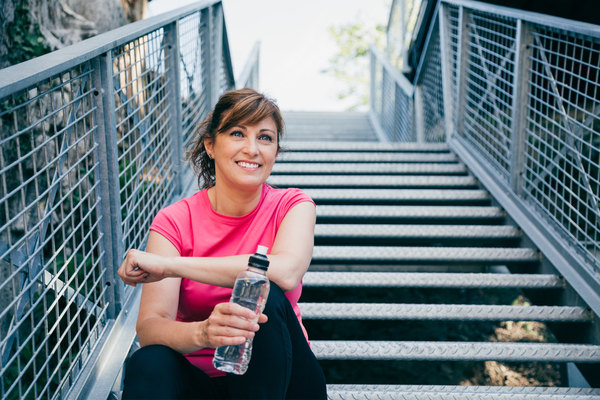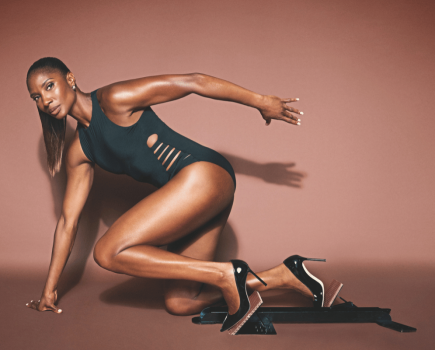Your body changes during the menopause so it’s good to adjust your workouts. Here’s how to target your moves to feel fitter and stronger.
There’s no better time to get active and enjoy fitness than when going through the menopause. And there’s no good reason why you can’t throw yourself into the sports and activities you love. The fact your body changes throughout this time simply means you may have to make some minor tweaks to your routine but it needn’t spell the end for donning your trainers and working up a sweat – in fact, exercise can even ease many symptoms, as our expert explains.
Everyone’s different
‘The menopause affects everyone differently and it’s all about working out what’s best for you,’ says personal trainer Stef Larden (bearwell.co).
‘One frequent talking point for many women is a fluctuation in energy levels. The best way to deal with it is to make small changes. So if you’re running low on energy one day, instead of forcing yourself to go for your usual run, switch to power walking. Or if you usually enjoy a game of tennis, try a doubles match. And if lifting weights is your usual thing, then try bodyweight exercises instead. You’ll reap the same rewards and hit the same post-workout high but without exhausting yourself.’
Working out is also an antidote to many menopausal symptoms, including metabolic issues, which can become more prevalent during menopause. A slowing of the metabolism (the rate at which you burn calories) can happen at this time because as you age, you tend to lose muscle mass.
Muscles are great calorie burners so as they decrease your metabolism slows down. It makes exercise vital for keeping you trim and healthy. ‘I recommend 90-150 minutes of moderate exercise each week,’ says Stef. ‘This could be as simple a two long walks. Just make sure you go hard enough to work up a sweat and get out of breath.’
Stef Larden works with retreat specialists &Breathe. Find out about their menopause retreat in the February issue.
Tighten up!
Firstly, menopause exercises must include some work on your pelvic floor. ‘Connective tissue can weaken during the menopause [because of the change in hormones] and so does your pelvic floor,’ explains Stef. ‘These exercises should be non-negotiable in all women’s fitness programmes, but particularly when going through the menopause.’ There are two kinds of pelvic floor exercise: the first consists of squeezing and releasing the muscles 10-15 times in a row. The second is to squeeze and hold the muscles for a few seconds, as if trying to stop urinating. Then inhale and exhale slowly while keeping them held. ‘Spend a few minutes doing each of these two or three times
a day to keep your floor strong,’ says Stef.
Stay supple
Simple stretches during the day can be just as valuable as a hard-core workout. ‘Maintaining mobility in your joints and stretching your muscles helps you stay supple and strong, particularly if you have to endure long days of sitting still, commuting or working at a computer as this can leave you
feeling stiff and achy,’ says Stef.
‘Take time each day for stretching exercises, such as rolling your shoulders, circling your wrists and relaxing your body down through each vertebra until your fingertips touch the floor.
Balance is another thing we must hold on to as we get older and practise it regularly. ‘Doing squats and lunges will help with balance and core stability – I recommend 10 of each three times a day.’
Maintain strength
‘Strength training using weights or resistance is a wonderful way to protect your bones and keep them strong,’ says Stef. ‘Decreasing oestrogen levels can mean a decrease in bone density, which can lead to osteoporosis. However, workouts using weights, such as 3-4kg dumbbells, or bodyweight exercises – such as squats and the plank – stimulate bone growth.
‘Impact exercises such as running and jumping also help to strengthen your bones, but if you have symptoms of osteoporosis you may be advised against high-octane activities. This doesn’t mean you need to avoid all cardio though. Instead, try building it into everyday life. Getting off a stop early on the bus or using the stairs rather than the lift all count.’
What about hot flushes?
‘Unfortunately there is little evidence that exercise can help to alleviate hot flush symptoms,’ explains Stef, ‘but we do know it increases oxygen around your body and this can only be a good thing.
We also know that exercise helps you sleep at night – something hot flushes can put paid to – so getting moving should help you get some shut-eye at least. The one slight moderation you may need to make is to move your workout to earlier in the day to avoid raising your body temperature at bedtime.’
Aim for a moderate exercise level – when you feel out of breath but are able to speak in short sentences. If you can only give one-word answers, you’re working too hard. If you can have a full-blown conversation, you’re not working hard enough!
TRY OUR FLAT BELLY MOVES…
Feeling more “apple-shaped” is common during menopause. Your distribution of fat tends to change as you age and the decreased oestrogen levels may play a role in this. But these three moves will help to burn fat, strengthen your core and tone your stomach.
Each one should be done for 40 seconds with a 20-second rest and repeated five times.
Squat to calf raise with weights
Stand with your feet a hip-width apart.
Squat down into a deep squat, then power up so you’re on the balls of your feet, lifting your arms into the air as you do so.
Then, come back down into a squat and repeat.
Add 3-4kg dumbbells to the move if you can, as this will work your arms at the same time and challenge you.
Lunge and shoulder press
Stand with your feet together holding a dumbbell in each hand just above your shoulders, out to the side, with elbows bent and your palms facing towards you.
Step one foot forward and lower your body until your knees are bent 90 degrees, pressing the weights above your head as you do so.
Return the weights to the start position as you push back to standing and repeat on the other leg.
Mountain climbers
Start off in a traditional plank position with your core engaged, bring your right knee forward under your chest, with your toes just off the ground.
Return to your basic plank. Switch legs, bringing your left knee forward.
Keep switching your legs and pick up the pace until it feels a little like running in a plank position.








